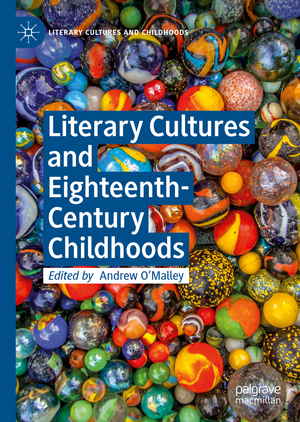Literary Cultures and Eighteenth-Century Childhoods: Literary Cultures and Childhoods
Editat de Andrew O'Malleyen Limba Engleză Hardback – 14 ian 2019
The essays in this volume offer fresh and innovative considerations both of how children interacted with the world of print, and of how childhood circulated in the literary cultures of the eighteenth century. They engage with not only the texts produced for the period’s newly established children’s book market, but also with the figure of the child as it was employed for a variety of purposes in literatures for adult readers. Embracing a wide range of methodological and disciplinary perspectives and considering a variety of contexts, these essays explore childhood as a trope that gained increasing cultural significance in the period, while also recognizing children as active agents in the worlds of familial and social interaction. Together, they demonstrate the varied experiences of the eighteenth-century child alongside the shifting, sometimes competing, meanings that attached themselves to childhood during a period in which it became the subject of intensified interest in literary culture.
Preț: 785.74 lei
Preț vechi: 958.21 lei
-18% Nou
Puncte Express: 1179
Preț estimativ în valută:
150.37€ • 163.28$ • 126.31£
150.37€ • 163.28$ • 126.31£
Carte tipărită la comandă
Livrare economică 23 aprilie-07 mai
Preluare comenzi: 021 569.72.76
Specificații
ISBN-13: 9783319947365
ISBN-10: 3319947362
Pagini: 313
Ilustrații: XVIII, 315 p. 15 illus.
Dimensiuni: 148 x 210 mm
Greutate: 0.55 kg
Ediția:1st ed. 2018
Editura: Springer International Publishing
Colecția Palgrave Macmillan
Seria Literary Cultures and Childhoods
Locul publicării:Cham, Switzerland
ISBN-10: 3319947362
Pagini: 313
Ilustrații: XVIII, 315 p. 15 illus.
Dimensiuni: 148 x 210 mm
Greutate: 0.55 kg
Ediția:1st ed. 2018
Editura: Springer International Publishing
Colecția Palgrave Macmillan
Seria Literary Cultures and Childhoods
Locul publicării:Cham, Switzerland
Cuprins
1. Introduction: Literary Cultures and Eighteenth-Century Childhoods - Andrew O’Malley.- 2. Age, Status, and Reading in the 18th Century - Teresa Michals.- 3. Circulating Childhood in Eighteenth-Century England: The Cultural Work of Periodicals - Anja Müller.- 4. Wards, and Apprentices: The Legal and Literary Construction of the Familial Position of the Child - Cheryl Nixon.- 5. 'Pray let none see this impertinent Epistle’: Children’s Letters and Children in Letters at the Turn of the Eighteenth Century - Adrianna Benzaquén.- 6. Learned Pigs and Literate Children: Becoming Human in Eighteenth-Century Literary Cultures - Ann Wierda Rowland.- 7. Fable and Family in Sarah Trimmer's Fabulous Histories - Heather Klemann.- 8. Eighteenth-Century Children’s Poetry and the Complexities of the Child’s Mind - Louise Joy.- 9. "Powers Expanding Slow": Children's "Unfolding" Minds in Radical Writing of the 1790s - Susan Manly.- 10. Mediocrity: Mechanical Training and Music forGirls - Donelle Ruwe.- 11. From Wild Fictions to Accurate Observations: Domesticating Wonder in Children’s Literature of the Late Eighteenth-Century - Richard De Ritter.- 12. "To Communicate Energy": Eliza Fenwick Cultures the New-World Child - Lissa Paul.- 13. In the Margins: Children and Graphic Satire in the Eighteenth Century and early Nineteenth Century - Sebastian Mitchell.- 14. Redefining the Gothic Child: An Educational Experiment? - Jessica Evans.- 15. Lemuel Hayes and "Little Adults": Race and the Prehistory of Childhood in Early New England - Jennifer Thorn.
Notă biografică
Andrew O’Malley is Associate Professor of English at Ryerson University in Toronto, Canada. He is the author of The Making of the Modern Child: Children’s Literature and Childhood in the Late Eighteenth Century (2003) and of Children’s Literature, Popular Culture, and Robinson Crusoe (2012).
Caracteristici
Very interdisciplinary - features work from scholars in a variety of other disciplines such as Education, History, Visual Culture/Art History etc Looks at at eighteenth-century childhoods from a variety of angles: as a set of expectations, desires, concerns, limitations, and capacities adults sought to address in their writing for young people; as a complex trope or symbol that performed a range of cultural work in the writings adults produced for one another; as a lived experience children recorded and actively shaped Examines a variety of literary cultures – novels, poetry, legal writing, periodicals, pamphlets, personal letters, graphic prints, and literature produced specifically for young readers




